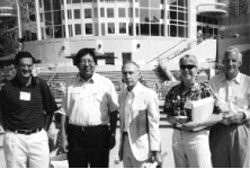> Back to Calendar
by Tom Tidwell
From 4-9 August 2002 at the University of California, San Diego,
280 chemists from 30 countries assembled for "Structure and Mechanism
in Organic Chemistry," the 16th International Conference
on Physical Organic Chemistry, which was sponsored by IUPAC. The
meeting featured 34 plenary and invited lectures, 93 contributed
lectures, and 128 posters.
The local organizer was Professor Charles L. Perrin, who is also
chair of the Subcommittee
on Structural and Mechanistic Chemistry of the IUPAC Organic
and Biomolecular Chemistry Division. A social and cultural program
included a welcoming reception, visits to the Mt. Palomar Observatory
and the San Diego Zoo, city and harbor tours, and a banquet at the
Birch Aquarium of the Scripps Institute for Oceanography.
The University of California at San Diego (UCSD) is now more than
40 years old, and the faculty has included nine Nobel Prize winners
in the sciences. The most recent is Walter Kohn, a 1998 winner in
chemistry who developed DFT computational methods at UCSD before
moving to U.C. Santa Barbara. Barry Sharpless, a 2001 winner in
Chemistry, is at the nearby Scripps Research Institute. The San
Diego campus is situated in a lovely environment on the Pacific
Ocean, in an area that has become a leading center of the biotechnology
industry in the United States. In addition to a benign summer climate,
the university has excellent conference facilities, with low-cost
student residences available for participants.
 |
|
Conference
participants outside the meeting room: Left to right; John
Toscano (Johns Hopkins U., Baltimore), Peter Chen (ETH, Zurich),
Charles L. Perrin (UCSD, Chair of Organizing Committee), JoAnn
DeLuca (Central Washington U.), and John Baldwin (Syracuse
U.)
|
The topics presented at the five-day meeting emphasized the diversity
of modern research in structural and mechanistic chemistry, with
particular emphasis on understanding chemical reactivity, intermolecular
recognition, supramolecular chemistry, biological systems, and materials.
A key topic was nanotechnology, including lectures on photochemically
activated molecular- level devices (Vincenzo Balzani, Bologna, Italy);
dynamics of contractile catenanes and rotaxanes (Jean- Pierre Sauvage,
Strasbourg, France); synthesis and operation of a molecular motor
(Ben Feringa, Groningen, Netherlands); and millimeter-scale selfassembly
and potential applications (George Whitesides, Harvard). Another
key topic was the analysis of the relation between structure and
biochemical function, including lectures on hydrogen tunneling in
enzyme-catalyzed reactions (Judith Klinman, U.C. Berkeley); kinetics
of self-replicating systems and selfassembly of nanoobjects based
on nucleic acids (Gunther von Kiedrowski, Bochum, Germany); genetic
selection as a tool for mechanistic enzymology (Donald Hilvert,
ETH, Zürich, Switzerland); chemical methods for modulating
cell-surface architecture (Carolyn Bertozzi, U.C. Berkeley); single-molecule
studies of the mechanism of protein unfolding (Jane Clarke, Cambridge,
U.K.); and the thermodynamics of some reactions of NO and NADH (Jin-Pei
Cheng, Nankai University, China). Other presentations dealt with
gasphase and solution reactivity and structure, including catalysis
of electron-transfer processes (Shunichi Fukuzumi, Osaka); low-coordination
silicon compounds (Yitzhak Apeloig, Haifa, Israel); salt effects
on conformations of heterocycles (Eusebio Juaristi, Mexico); mass
spectrometric detection of organometallic intermediates in new catalytic
processes (Peter Chen, ETH, Zurich); and synthesis of novel cyclopropane
derivatives (Armin de Meijere, Gottingen, Germany).
This symposium continues an impressive series of scientific presentations,
following the trajectory of the plenary lecture by K.
R. Seddon at the 15th Conference in 2000 in Göteborg,
Sweden. That lecture was published in Pure and Applied Chemistry
in 2001 and was ranked in the top 10 requested articles from the
Chemical Abstracts document service. The 17th conference
is scheduled for Shanghai in 2004, and is expected to continue to
showcase the growth and development of this field.
*
Since it has been an ICPOC tradition to include artwork in conference
programs, Professor Perrin chose one of his wife’s pieces for
all to enjoy. Enlarged
piece can be viewed in color at <chem-faculty.ucsd.edu/perrin/icpoc>.
Tom
Tidwell, University of Toronto, is president of the IUPAC Division
of Organic and Biomolecular Chemistry.

